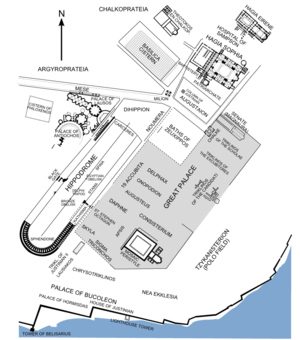De Ceremoniis

The De Ceremoniis (fully De cerimoniis aulae Byzantinae) is the conventional Latin name for a book of ceremonial protocol at the court of the Byzantine emperors in Constantinople. Its Greek title is often cited as Ἔκθεσις τῆς βασιλείου τάξεως ("Explanation of the Order of the Palace"), taken from the work's preface, or Περὶ τῆς Βασιλείου Τάξεως ("On the Order of the Palace"). In non-specialist English sources, it tends to be called the Book of Ceremonies of Constantine VII Porphyrogennetos (variably spelt), a formula used by writers including David Talbot Rice and the modern English translation.
History and Sources
It was written or at least commissioned by Emperor Constantine VII (reigned 913-959), probably around 956-959. The compilation of Rep. I 17 (Leipzig, Universitätsbibliothek) was partially revised later under Nikephoros II (963-969), perhaps under the supervision of Basil Lekapenos, the imperial parakoimomenos, and it also contains earlier descriptions of the 6th century.[1]
One of the book's appendices are the Three Treatises on Imperial Military Expeditions, a war manual written by Constantine VII for his son and successor, Romanos II.
Composition

In its incomplete form chapters 1-37 of book I describe processions and ceremonies on religious festivals (many lesser ones, but especially great feasts like the Elevation of the Cross, Christmas, Epiphany, Palm Sunday, Good Friday, Easter and Ascension Day and saint's days like St Demetrius, St Basil etc. often extended over many days), while chapters 38-83 describe secular ceremonies or rites of passage like coronations (38-40), weddings (39,41), births (42), funerals (60), or the celebration of war triumphs during feasts at the Hippodrome like Lupercalia (73).[2]
These protocols gave rules for imperial progresses to and from certain churches at Constantinople and the imperial palace,[3] with fixed stations and rules for ritual actions and acclamations from specified participants (the text of acclamations and processional troparia or kontakia, but also heirmoi and stichera are mentioned), among them also ministers, senate members, leaders of the "Blues" and the "Greens" during the hippodrome's horse races who had an important role during court ceremonies.[4] The following chapters (84-95) are taken from a 6th-century manual by Peter the Patrician. They rather describe administrative ceremonies like the appointment of certain functionaries (ch. 84,85), investitures of certain offices (86), the reception of ambassadors and the proclamation of the Western Emperor (87,88), the reception of Persian ambassadors (89,90), Anagorevseis of certain Emperors (91-96), the appointment of the senate's proedros (97). The "palace order" did not only prescribe the way of movements (symbolic or real) like on foot, mounted, by boat, but also the costumes of the celebrants and who has to perform certain acclamations. The emperor often plays the role of Christ and the imperial palace is chosen for religious rituals, so that the ceremonial book brings the sacred and the profane together. Book II seems to be less normative, it rather describes particular ceremonies as they had been celebrated during particular imperial receptions of the past.
The second book follows a very similar composition: (1) religious feasts and the more or less mythological description of certain palace buildings according to the Macedonian Renaissance,[5] (2) secular ceremonies and imperial ordonations,[6] (3) imperial receptions and war festivities at the hippodrome. But its descriptions remember later customs of the Porphyrogennetos dynasty, including those of Constantine and his son Romanos. It seems that book I was compiled during the time, when Constantine commissioned the ceremonial book, but the project was continued by later chronists after his lifetime.
See also
References
- ↑ "De Ceremoniis" in The Oxford Dictionary of Byzantium, Oxford University Press, New York & Oxford, 1991, p. 595. ISBN 0195046528. Featherstone, Jeffrey Micael (2002). "Preliminary Remarks on the Leipzig Manuscript of De Cerimoniis". Byzantinische Zeitschrift. 95: 457–479. doi:10.1515/BYZS.2002.457. Featherstone, Michael; Jana Grusková; Otto Kresten (2006). "Studien zu den Palimpsestfragmenten des sogenannten "Zeremonienbuches" I. Prolegomena". Byzantinische Zeitschrift. 98 (2): 423–430. doi:10.1515/BYZS.2005.423.
- ↑ For a discussion of the ceremonial book's composition, but also on details of certain ceremonies, see: Bury, John Bagnell (1907). "The Ceremonial Book of Constantine Porphyrogennetos". The English Historical Review. 22: 209–227;426–448. doi:10.1093/ehr/xxii.lxxxvi.209.
- ↑ See also the reconstruction of "Constantinople about 1200". Byzantium 1200. 2009. a three-dimensional model of the quarter, and the presentation of a reconstruction by Jan Kostenec.
- ↑ The hippodrome was as important for court ceremonies as the Hagia Sophia for imperial religious ceremonies and rites of passage. It was not only used during horse races, but also for receptions and its banquets and the yearly celebration of Constantinople's inauguration on 11 May. The "Golden Hippodrome" was an own ceremony to inaugurate a new season and to fix the calendar of the ceremonial located in the hippodrome. Occasionally also votive horse races were given, like on 22 July for the feast of Saint Elias. Woodrow, Zoe Antonia (2001). "Imperial Ideology in Middle Byzantine Court Culture: The Evidence of Constantine Porphyrogenitus's 'De ceremoniis'". Durham University.
- ↑ Featherstone, Jeffrey Michael (2013). "Der Grosse Palast von Konstantinopel: Tradition oder Erfindung?". Byzantinische Zeitschrift. 106: 19–38. doi:10.1515/bz-2013-0004.
- ↑ Featherstone, Jeffrey Michael (2008). "Δι' Ἔνδειξιν : Display in Court Ceremonial (De Cerimoniis II,15)". In Anthony Cutler, Arietta Papaconstantinou (eds.). The Material and the Ideal: Essays in Mediaeval Art and Archaeology in Honour of Jean-Michel Spieser. Leiden: Brill. pp. 75–112. ISBN 9789004162860.
Edition and Translation
| Wikisource has original text related to this article: |
- Reiske, Johann Jakob; Leich, Johannes Heinrich, eds. (1829). Constantini Porphyrogeniti Imperatoris De Ceremoniis Aulae Byzantinae libri duo graece et latini e recensione Io. Iac. Reiskii cum eiusdem commentariis integris. Corpus Scriptorum Historiae Byzantinae. 1 (Leipzig (1751-54) ed.). Bonn: Weber.
- Reiske, Johann Jakob; Leich, Johannes Heinrich, eds. (1830). Constantini Porphyrogeniti Imperatoris De Ceremoniis Aulae Byzantinae libri duo graece et latini e recensione Io. Iac. Reiskii cum eiusdem commentariis integris. Corpus Scriptorum Historiae Byzantinae. 2 (Leipzig (1766) ed.). Bonn: Weber.
- Ann Moffatt tr., eds. (2012). Konstantinos Porphyrogennetos: The book of ceremonies in 2 volumes. Byzantina Australiensia (Reiske ed.). Canberra: Australian Association for Byzantine Studies. ISBN 1876503424.